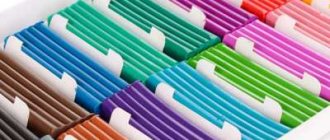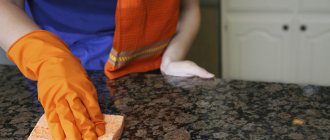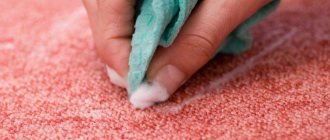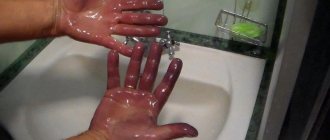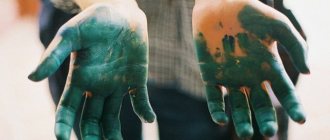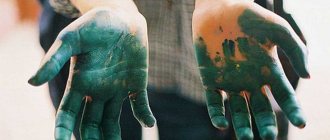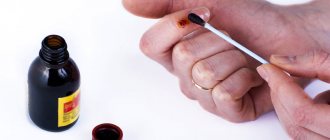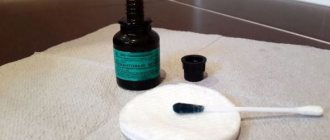Something terrible happened - you spilled iodine on your favorite furniture. And how not to spill, because these bubbles open so awkwardly! How to remove iodine stains? Even the most careful housewives sometimes get things out of hand. Spilled iodine stains things, furniture and any objects that cannot be wiped off with a damp cloth. How to remove iodine stains so that no traces remain? More effective means are needed.
Fixer
You can remove iodine with a product such as Fixer. Fixer can be purchased in the department where they sell everything for photographs. Perhaps you are interested in photography, and you have a bag of fixer lying around at home - this is what you need! Since childhood, we have known that fixer does an excellent job of removing iodine stains. We dilute the fixer with water and wipe away the trace of iodine. After treating with the fixer, you need to wipe the furniture with a solution of laundry soap.
How to wash green paint
If it gets on your skin
In general, you can do nothing. Human skin renews itself regularly, so the spots will fade over time. If you can't wait, use:
- Alcohol or any strong alcohol . Dampen a cotton swab or rag and rub the stain firmly. This method is the simplest and most universal, but, alas, is not suitable for those with dry or sensitive skin.
- Hydrogen peroxide or chlorhexidine digluconate. These liquids are sold at any pharmacy at affordable prices and are milder than alcohol.
- Makeup remover. Especially if the green paint gets on the thin skin of the eyelids or lips. The stain will not disappear the first time, but if you wipe the stain 4-5 times a day, it will come off faster.
If green paint gets on your clothes
It is much more difficult to remove green stains from things than from skin. Firstly, not all fabrics can be washed with aggressive detergents. Secondly, you need to act as quickly as possible: the older the stain, the more difficult it is to remove.
If an expensive item is dirty, the best solution is to go to the dry cleaner. For those who are ready to try to wash off the brilliant green on their own, we advise you to arm yourself with:
- Fat cream. The most gentle method for the most delicate items. Apply a thick layer of cream onto the stain, leave for 2-4 hours, and then wash the item with powder.
- Soapy solution. Works great on woolen items. Mix 3-5 tablespoons of liquid or grated bar soap in ½ liter of water. Treat the stain with this solution or soak the entire garment. Leave the green stuff to soak for 10–30 minutes and rinse the items with clean water.
- "Whiteness." Stains on light-colored clothing can be treated with this cheap bleach. Afterwards, the item will need to be washed in a washing machine with your usual detergents.
- Stain remover. The household chemicals market regularly pleases us with new inventions. Use your favorite bleach or stain remover, following the manufacturer's instructions. Most often, it is enough to apply the product to the dirt and then add it to the washing machine.
If green paint gets on the furniture
If furniture made of plastic, glass, varnished wood, chipboard, MDF, leather or leatherette is stained with green paint, wipe the surface with a damp cloth and carefully work on the stain with an eraser. If the eraser doesn't help, try removing the green paint with alcohol. If the furniture is made of untreated wood, unfortunately, you will have to use sandpaper.
If green paint gets on the fabric, follow the recommendations for removing stains from clothing. Just in case, we advise you to first check the reaction of the material to the cleaning agent. And if the furniture is especially valuable to you, contact a dry cleaner.
At home, it is safest to use a special stain remover. Apply the detergent concentrate or solution (according to the instructions) on the stain for several hours, and then wipe off the residue with a damp cloth.
If green stuff gets on the floor
How to remove brilliant green from linoleum, laminate or parquet
Act as quickly as possible. As soon as the green paint has spilled, blot up the excess with a napkin and do not let the stain spread all over the floor.
Wipe off stains with alcohol or strong alcohol. If you don’t have anything like this on hand, take gasoline, kerosene or glass washing liquid.
Wash off any remaining green paint with a stiff brush and soapy water.
How to remove green stains from carpet
You can’t hesitate here either. Blot any spilled green paint with a soft cloth so that it does not have time to penetrate deep into the fibers of the carpet. And immediately start treating the stain with a soap solution, a solution of washing powder (3-4 tablespoons per ½ liter of water) or a stain remover. If the carpet has short pile, try to remove the green stuff with a brush. If the pile is long, remove excess liquid with a clean cloth.
If all else fails, try a 10 percent ammonia solution. Be careful: it has a pungent odor that can remain in the apartment for a long time. Soak a rag or cloth napkin in ammonia and rub the stain vigorously.
Aspirin
How to remove iodine from furniture? Traces of iodine can be easily removed by having simple aspirin (acetylsalicylic acid) in your medicine cabinet. A solution of 1 aspirin tablet dissolved in half a glass of water can easily cope with furniture without upholstery. It should be remembered that the fresher the trace of iodine, the easier it is to remove it without the risk of damaging the contaminated surface.
How to wash iodine
If it gets on your skin
Iodine disappears from the skin even faster than brilliant green. The following will help speed up the process:
- Soap. Wash your skin thoroughly with soap. Household stuff, although it doesn’t smell very nice, will be the most effective. Especially if you add a good stiff brush to it.
- Baking soda. Wet the skin with water and rub with baking soda. Do this over a sink or basin: the powder will fall off during the process. Leave the baking soda on the stain for 10-15 minutes, and then wash off the residue. After this procedure, it is advisable to apply a moisturizer: baking soda dries the skin.
- Alcohol. Wipe the stain with a cotton swab dipped in alcohol or strong alcohol - the stain will become noticeably lighter.
- Hydrogen peroxide. Wipe the skin with a cotton swab soaked in this antiseptic. Peroxide penetrates deeply into the pores and is safe for the epithelium. It is great if you need to wash off iodine from your face.
- Lemon. Squeeze some juice onto a cloth and rub the stain vigorously. Be careful with mucous membranes: if you clean the area around the eyes, mouth or nose with lemon, you can get burned.
If iodine gets on your clothes
Iodine is difficult to remove from fabric, but the sooner you begin to eliminate the stain, the greater the chance of restoring cleanliness to your clothes. You can remove dirt:
- Potato starch. Soak the items in warm water for 10–20 minutes and then wring them out. Sprinkle starch generously onto the stain, rub into the fibers with your hands and leave for 15 minutes. Rinse off the starch with clean water. If the stain turns out to be particularly stubborn, repeat the procedure several times. Then wash the clothes in the washing machine as usual.
- Ammonia. Add 10–15 drops of ammonia to a glass of water, pour it into a basin with clothes and add a liter of warm water. Leave the items to soak for 15–20 minutes, and then rinse them and wash as usual.
- Acetone. If something is dirty that you don’t want to wash, wipe it with a cotton swab soaked in acetone. Nail polish remover will also work.
If iodine gets on furniture
If the furniture is upholstered in fabric, use clothing cleaning methods. Don’t worry about wooden decorative elements: the iodine will evaporate from their surface on its own. Furniture made of plastic, glass, lacquered wood, chipboard, MDF, leather or leatherette can be washed:
- Potatoes. Cut the tuber in half and thoroughly wipe away any dirt. If necessary, the potatoes can be left on the stain for several hours: they will absorb the remaining iodine.
- Fixer for photographs. If you are an amateur photographer, there will be no problems with iodine removal. Take sodium thiosulfate and treat the stain with it. Then wipe the surface of the furniture with a damp cloth.
- Ascorbic acid. Dissolve 1-2 tablets in 100 ml of water. Soak a cotton swab in the liquid and wipe the stain until it disappears.
If iodine gets on the floor
How to remove iodine from linoleum, laminate or parquet
If the stain is not in the most visible place, you don’t have to worry too much: over time, the iodine will evaporate without your intervention. If you don't want to wait, use:
- Any detergent. Lather up a dish sponge or brush and scrub the stain thoroughly. If it doesn't disappear completely, it will at least become lighter.
- "Whiteness." Add 2-3 tablespoons of solution per liter of water, soak a rag in the liquid and cover the stain with it. If necessary, leave the stain to soak for several hours, and then wipe the floors with a cloth dampened in clean water.
- Baking soda. Moisten the iodine stain with warm water, sprinkle baking soda on top and cover with a damp cloth. Leave for 10–12 hours, and then wash the floors as usual.
Method number 5. Sea salt
Sea salt can remove traces of antiseptic even in particularly severe cases. It is best to take a bath if the stain is too extensive, or simply put your hands in a container with dissolved sea salt.
You should rub only with a soft sponge saturated with ordinary laundry soap.
This product usually copes quite quickly with severe stains on fabric.
Adviсe
Do not forget that each type of linoleum is good in its own way, and not every type will withstand the “test” by all means, and therefore if, when using one product, linoleum begins to lose color, cleansing with this substance should be stopped and another method, less chemical, should be tried.
If the stain is minor and does not change the appearance of the room, or there is no money, time or effort to remove the stain, then you should not panic. You can just wait a few weeks without paying attention to it. You yourself will notice that the stain has disappeared and evaporated. And this is not fiction. Iodine is a volatile substance and when exposed to sunlight, it disappears. Therefore, you should create conditions for more light to hit the spot, and it will evaporate.
How to remove iodine stains from clothes
There are chemical and traditional ways to remove iodine stains. In both categories there are universal products that can be used to clean any surface.
Sodium thiosulfate
The remedy, usually used to treat poisoning, also helps in the fight against iodine stains on fabrics.
Instructions:
- We treat the stain with an injection solution.
- Wash off with water.
- We repeat the procedure.
- Wash with soapy water and rinse off the residue with clean water.
Sodium thiosulfate is used to cleanse the body of the effects of intoxication, but also effectively cleanses tissues of iodine
How to remove iodine with sodium thiosulfate - video
Professional stain removers
Professional products for whitening bed linen and removing stains from clothes, for example, Vanish Oxi Action, help cope with even old iodine stains. They should be used in accordance with the recommendations on the packaging, always taking into account the type of fabric. Usually, you need to pour a little product onto the stain, let it sit and then wash it, adding a little of this stain remover to the powder.
Vanish Oxi Action is a professional stain remover, including iodine stains
Folk remedies
- The combination of soda and vinegar is one of the most common folk methods for removing traces of antiseptic on clothes. But on delicate fabrics its effect must be tested on an inconspicuous area. Instructions:
- pour baking soda onto the stain;
- drip vinegar on top and leave for at least 3 hours (in some cases the time has to be increased to 12 hours);
- rinse and wash the fabric.
- Dishwashing gel. The product is poured onto the fabric and left for 2-4 hours. Then you need to moisten with water, foam, wait another half hour and wash the laundry in the usual way.
- Iron. Some fabrics can be cleansed of iodine by applying high temperatures:
- place a piece of white cloth made of natural fibers under the area of contamination;
- cover with the same piece on top and iron for 10–15 minutes;
- wash the clothes.
How to remove iodine from laundry - folk methods: gallery
How to remove iodine from laundry made from different types of fabric
Let's group the known methods of removing stains by type of material, arranging these methods in descending order of effectiveness.
White and colored cotton
Nail polish remover, hydrogen peroxide, and ammonia are equally effective in removing iodine from cotton materials.
It is only important to properly dilute them with water:
- ammonia, peroxide - 1 tbsp. l. for 1 liter of water;
- acetone, denatured alcohol - 1:1 (for white fabrics it is not necessary to dilute)
Instructions:
- Wet the tampon in the liquid.
- Apply to the stain, lightly rub.
- Rinse with running water and wash.
The “Mole” pipe cleaner can only be used on undyed fabrics.
Instructions:
- Apply the product (powder or gel) to the stain.
- Leave for 5-10 minutes, then rinse and wash as usual.
After removing stains, fabrics can be bleached.
"Mole" can only be used on white natural fabrics
Jeans
The most effective way to remove stains from jeans and any other blue or black material is to use starch. The principle of stain removal is based on the chemical reaction of iodine and starch - the area on jeans filled with antiseptic takes on a blue tint.
Instructions:
- We wet the stain with cool water and sprinkle it generously with potato starch.
- Spray a little water onto the powder from a spray bottle and leave for 10–15 hours.
- Rinse the jeans and wash as usual.
Potato starch turns iodine stain blue
Delicate fabrics
This category of materials is very sensitive to any cleaning agents, so you need to be especially careful when working with them. If the stain is small, you can use raw potatoes - the mark will fade. Instructions:
- Cut the potato and apply it to the stain.
- Leave for 5-6 hours, then rinse.
- We wash in the usual way.
You can also try citric acid (a weak solution) or a piece of fresh lemon:
- Apply the product to the stain.
- Leave for 10 minutes.
- Rinse and wash.
The concentration of citric acid to remove iodine from tissue should be minimal
How to remove blemishes from face
Facial skin is thinner and more sensitive, so it requires more careful treatment. To cleanse iodine stains, use hypoallergenic gentle products, otherwise the procedure may lead to an allergic reaction or burns.
Fat cream.
Apply a thick layer of cream to the stain. Leave the product on for 10 minutes, but do not rub it into the skin. Afterwards, carefully remove the cream and wipe the area with facial lotion. Instead of cream, you can use cosmetic oil.
Laundry soap.
This is a hypoallergenic product without fragrances or aggressive components. Wet the bar with water and rub it in your hands until a thick foam appears. Apply it to the contaminated area and let it dry. Then gently wipe with a cotton pad and rinse off any remaining soap.
Sea salt and honey.
To cleanse your face of brown spots, prepare a scrub by mixing 2 parts honey and 1 part sea salt. Gently rub the mixture into the skin, then wipe off the mixture with a soft cloth.

